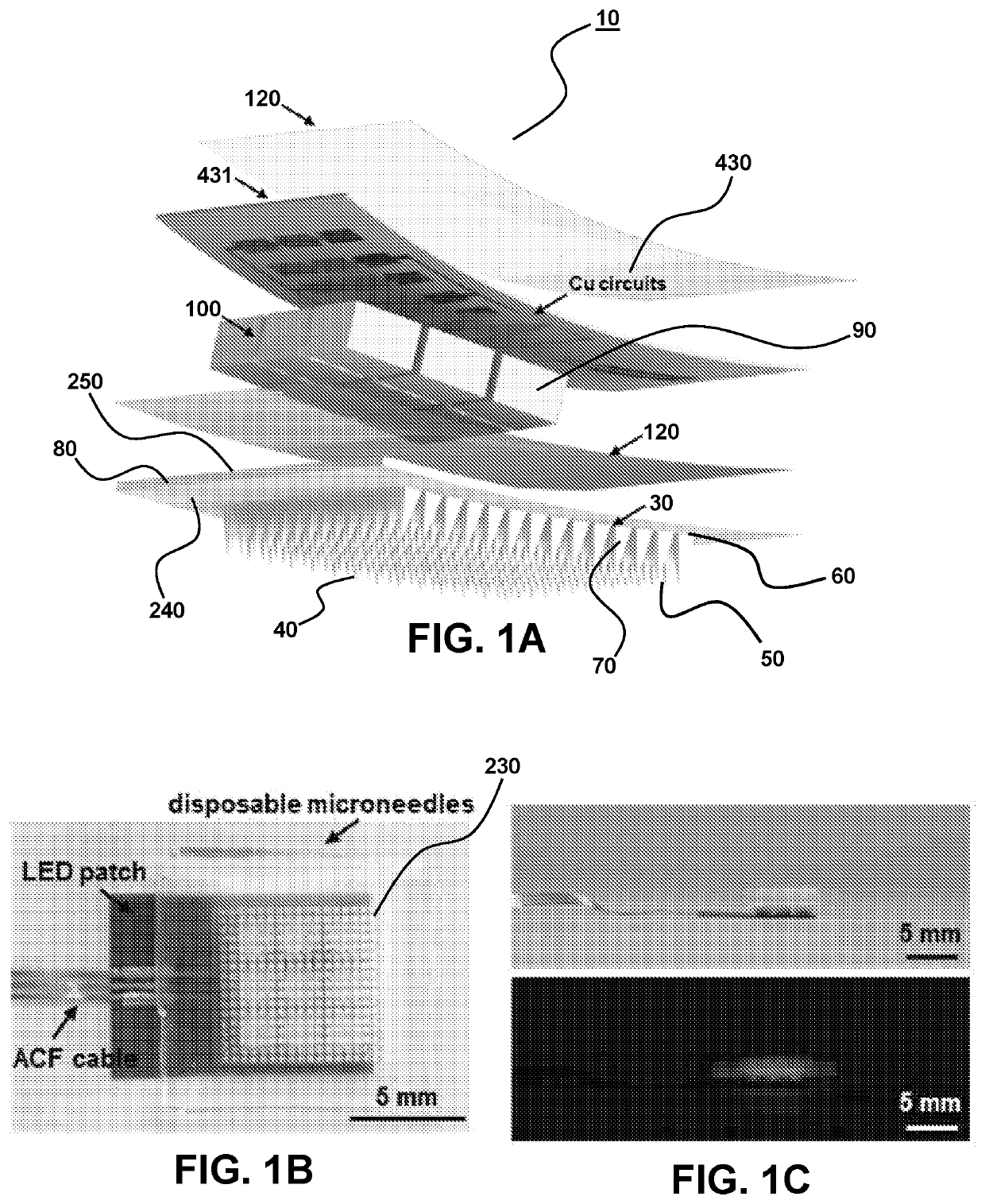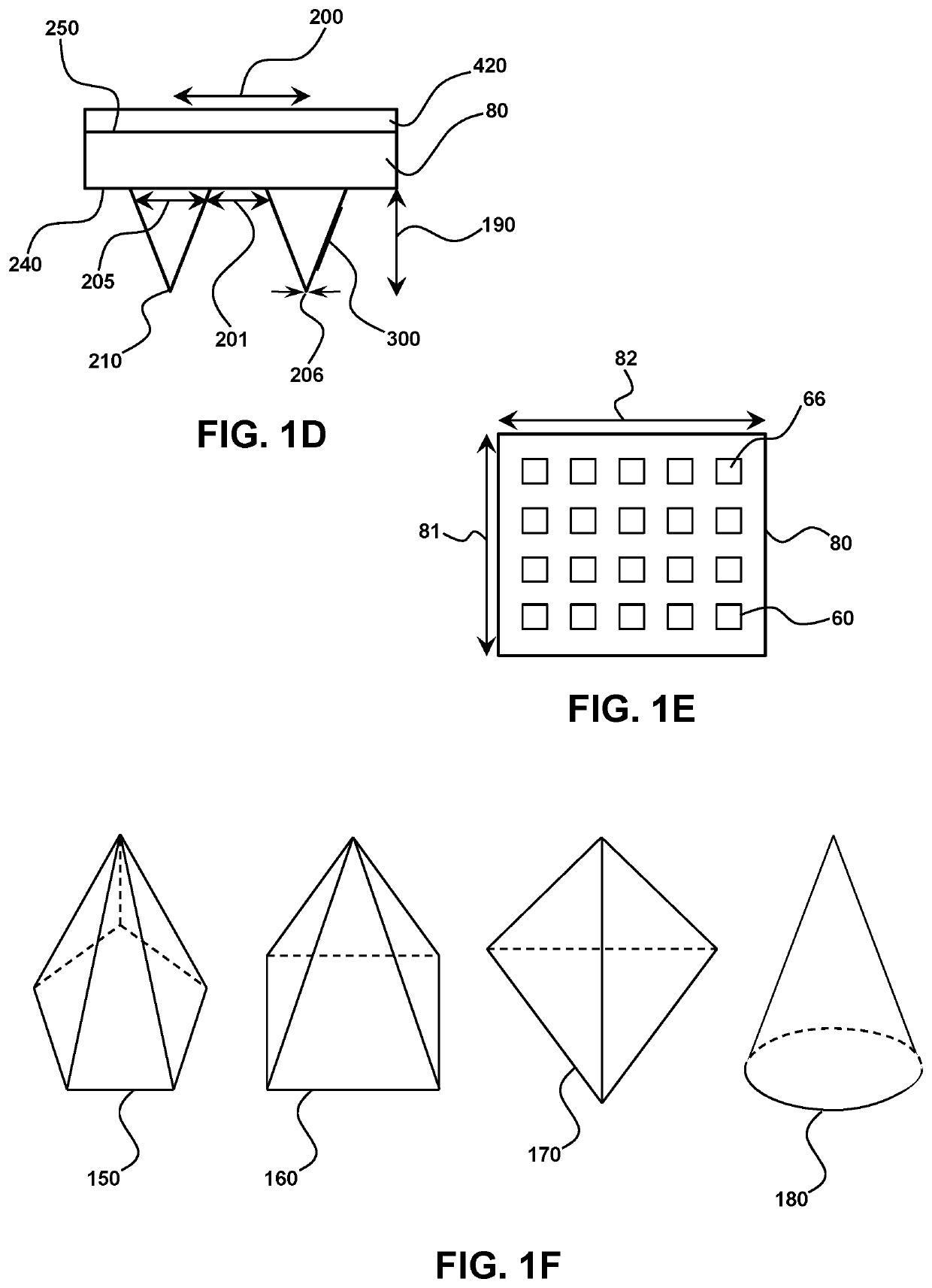Devices and methods for light delivery
- Summary
- Abstract
- Description
- Claims
- Application Information
AI Technical Summary
Benefits of technology
Problems solved by technology
Method used
Image
Examples
example 1
nd Methods for Light Delivery
[0138]The lack of availability, non-targeted nature, and inadequate light delivery into deep dermis of current light therapy devices underscore the need for more accessible, selective, and high-efficacy light therapy devices. Using advanced techniques in flexible electronics, provided herein is a soft, conformable, and depth-modulated phototherapy device. The device's top layer has an array of light emitting diodes of various wavelengths (e.g. UVA-1 LEDs with a spectral peak output of 360-nm), fully embedded within a substrate, including a flexible silicone. The bottom layer includes a dense array of tissue penetrating members, such as microneedles from bioresorbable poly-lactic-co-glycolic-acid (PLGA), a polymer enabling 99% of UVA transmittance, which create micro-channels 700 μm for deeper UVA-1 delivery into the skin. Optical modeling, confirmed by confocal microscopy in agarose, demonstrates that the PLGA microneedle waveguides increase light transm...
example 2
REFERENCES FOR EXAMPLE 2
[0217]1. American Academy of Dermatology Work, G.; Menter, A.; Korman, N. J.; Elmets, C. A.; Feldman, S. R.; Gelfand, J. M.; Gordon, K. B.; Gottlieb, A.; Koo, J. Y.; Lebwohl, M.; Leonardi, C. L.; Lim, H. W.; Van Voorhees, A. S.; Beutner, K. R.; Ryan, C.; Bhushan, R., Journal of the American Academy of Dermatology 2011, 65 (1), 137-74.[0218]2. Wong, T.; Hsu, L.; Liao, W., J Cutan Med Surg 2013, 17 (1), 6-12.[0219]3. Lapolla, W.; Yentzer, B. A.; Bagel, J.; Halvorson, C. R.; Feldman, S. R., Journal of the American Academy of Dermatology 2011, 64 (5), 936-49.[0220]4. Evans, C., Am J Manag Care 2016, 22 (8 Suppl), s238-43.[0221]5. Rachakonda, T. D.; Schupp, C. W.; Armstrong, A. W., Journal of the American Academy of Dermatology 2014, 70 (3), 512-6.[0222]6. Teske, N. M.; Jacobe, H. T., Clin Dermatol 2016, 34 (5), 614-22.[0223]7. Stege, H.; Berneburg, M.; Humke, S.; Klammer, M.; Grewe, M.; Grether-Beck, S.; Boedeker, R.; Diepgen, T.; Dierks, K.; Goerz, G.; Ruzicka, ...
example 3
REFERENCES FOR EXAMPLE 3
[0279]1. Menter A, Korman N J, Elmets C A, et al. Guidelines of care for the management of psoriasis and psoriatic arthritis: section 4. Guidelines of care for the management and treatment of psoriasis with traditional systemic agents. Journal of the American Academy of Dermatology. 2009; 61(3): 451-485.[0280]2. Naldi L, Griffiths C E. Traditional therapies in the management of moderate to severe chronic plaque psoriasis: an assessment of the benefits and risks. Br J Dermatol. 2005; 152(4):597-615.[0281]3. Staidle J P, Dabade T S, Feldman S R. A pharmacoeconomic analysis of severe psoriasis therapy: a review of treatment choices and cost efficiency. Expert Opin Pharmacother. 2011; 12(13): 2041-2054.[0282]4. Babalola O, Strober B E. Management of psoriasis in pregnancy. Dermatol Ther. 2013; 26(4):285-292.[0283]5. Alm utawa F, Alnomair N, Wang Y, Hamzavi I, Lim H W. Systematic review of UV-based therapy for psoriasis. American journal of clinical dermatology. 2...
PUM
 Login to View More
Login to View More Abstract
Description
Claims
Application Information
 Login to View More
Login to View More - R&D
- Intellectual Property
- Life Sciences
- Materials
- Tech Scout
- Unparalleled Data Quality
- Higher Quality Content
- 60% Fewer Hallucinations
Browse by: Latest US Patents, China's latest patents, Technical Efficacy Thesaurus, Application Domain, Technology Topic, Popular Technical Reports.
© 2025 PatSnap. All rights reserved.Legal|Privacy policy|Modern Slavery Act Transparency Statement|Sitemap|About US| Contact US: help@patsnap.com



